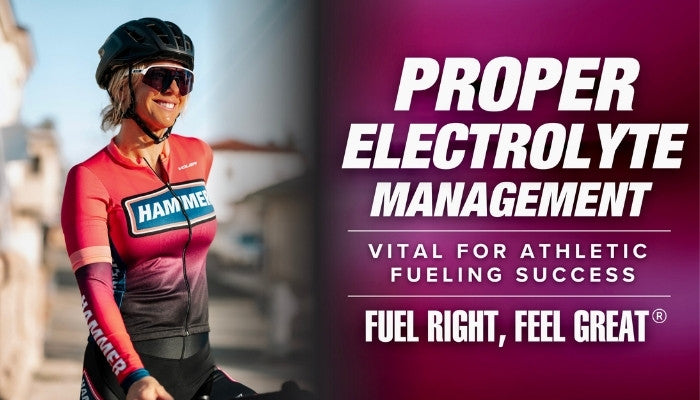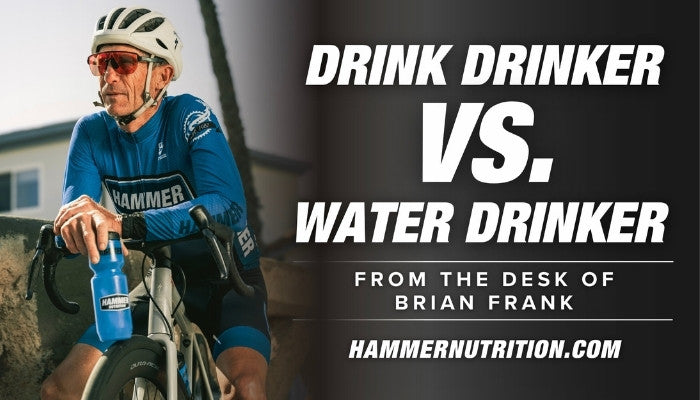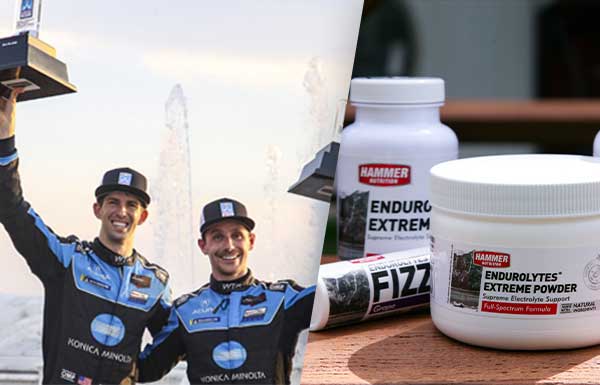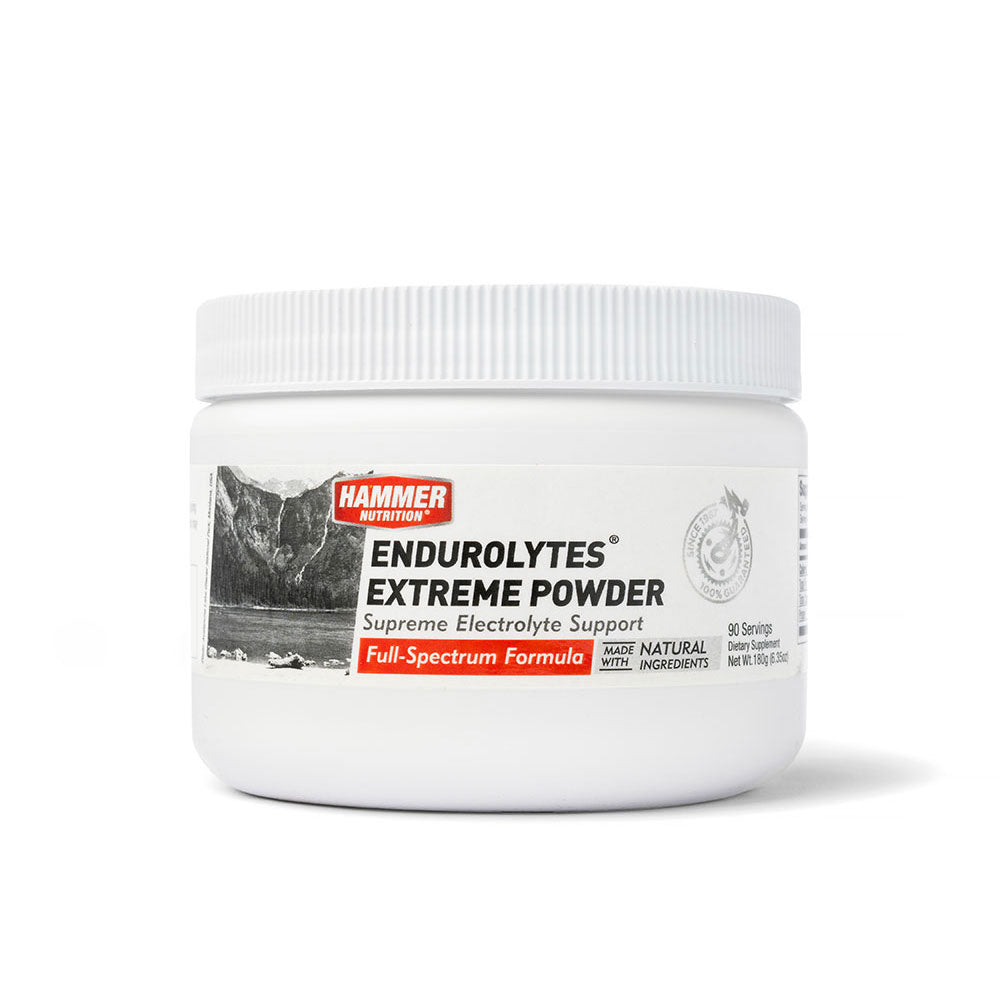



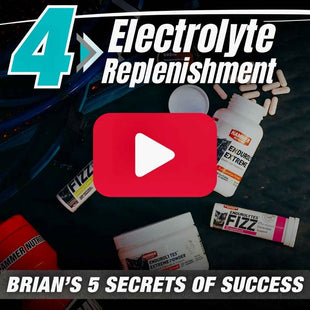

Endurolytes® Extreme Powder
- Dissolves quickly and completely
- 3x the sodium and potassium as original Endurolytes
- 90 Servings
Also available as Endurolytes Extreme capsules
(1 capsule = 1 scoop)
Quantity:







All the benefits of our best-selling Endurolyte Extreme capsules are now offered in an easy-to-mix powder. This all-new formula dissolves quickly and completely, with a subtle, natural watermelon flavor. Consume in water alone or add it to your liquid fuels according to your unique dosing needs. The mild flavor makes it easy to drink all day, while the lack of residue makes it perfect for hydration packs and bottles of any form.
With three times the sodium chloride and potassium, and a softer flavor profile than Fizz, this is the perfect solution for multihour bottles of fuel, those who dislike consuming capsules, and those whose electrolyte needs are high. Regardless of the conditions, duration, or intensity of your activities, Endurolytes Extreme Powder has you covered.
Also available: Endurolytes Fizz, Endurolytes, & Endurolytes Extreme
- What’s the difference between Endurolytes, Endurolytes Extreme, and Endurolytes Extreme Powder?
- How do I determine the equivalent of one scoop of Endurolytes Extreme Powder?
- What are your thoughts on sweat tests?
- Why do I need electrolytes?
- Do I need to take one of the Endurolytes products with Perpetuem?
- Can I take Anti-Fatigue Caps with any Endurolytes?
- Is the flavor of Endurolytes Extreme Powder mild?
- Do any of the Endurolytes products contain caffeine?
- Why do I need to use one of the Endurolytes products?
- In what ways are Endurolytes Extreme Powder different then Endurolytes Extreme in capsules?
- Which of your Endurolytes products contain the least possible amount of citric acid?
- Is Endurolytes Extreme Powder carbonated like Endurolytes Fizz?
- Are all the Endurolytes products gluten-free?
- Does Endurolytes Extreme Powder mix completely in solution?
- How much manganese in Hammer fuels?
- Do any of the Endurolyte products have exposure to allergens?
What’s the difference between Endurolytes, Endurolytes Extreme, and Endurolytes Extreme Powder?
Endurolytes is our original electrolyte replenishment supplement. Its precise blend of sodium chloride (salt), calcium, magnesium, potassium, and manganese is ideal for athletes who consume a low-to-moderate sodium diet.
Endurolytes Extreme contains 300 mg of sodium chloride (salt) and 75 mg of potassium per capsule—three times more than the original Endurolytes formula. You can use Endurolytes under any weather conditions, but here are the times when Endurolytes Extreme may be the more-ideal option.
1) If you're competing in an unusually hot-weather event. Some races, such as Ironman Kona and the Badwater 135, are held in hotter and/or more humid conditions than anything most of us will ever experience. On these extraordinary occasions, "normal" electrolyte replenishment plans need to be altered drastically. That's where Endurolytes Extreme shines. You'll be able to fulfill your body's exceptionally high electrolytic mineral needs more completely with Endurolytes Extreme, while taking fewer capsules than you would with Endurolytes.
2. If you're not acclimated to the weather conditions. When the weather is hotter than you're used to, you must alter a few things to succeed in your workout or race. First, you must slow down; you simply can't do "business as usual," pace-wise. Equally important, you must lower your caloric intake, while conscientiously increasing your fluid and electrolyte intake. Endurolytes Extreme takes care of the latter in ideal fashion.
3. If you consume a high-sodium diet. We'll never stop advocating the health and performance-enhancing benefits of a low-sodium diet. We continue to urge you to limit your dietary sodium intake to 1,500-2,300 mg a day (that's 3,750-5,750 mg of salt). The less sodium (salt) you consume, the less sodium your body will lose during exercise.
As you transition to a lower-sodium diet, you will need to replenish with more sodium during exercise, using Endurolytes Extreme to fulfill your electrolyte requirements. Several weeks after you've faithfully adhered to a low-sodium diet, you can go back to using Endurolytes. Of course, if you continue to eat a high-sodium diet and/or if you "sodium load" in the days prior to an event (a practice we don't advocate), you'll want to stick with Endurolytes Extreme.
4. If you are "physiologically predisposed" to cramping. Some athletes have cramping issues, even after following our fluid and electrolyte replenishment recommendations, which consistently work for the overwhelming majority of athletes. For example, we have a few clients who, due to their unique physiology, need to take 6 or more Endurolytes capsules hourly—even under mild-weather conditions—or they experience cramping problems. Athletes who have unusually high sweat rates (which means higher-than-normal sodium losses as well) also fall into this category. If either or both describes you, Endurolytes Extreme is a must-use product.
5. If you are just beginning early season training. The less fit you are, and especially if your early season training is intense and/or long in duration, the more sodium, chloride, and potassium you will lose. Until your fitness level increases and your body becomes more efficient, Endurolytes Extreme is your go-to electrolyte replenishment product.
How do I determine the equivalent of one scoop of Endurolytes Extreme Powder?
No scoop? No problem! With the following conversion information, your "Where did my scoop go?" problems are resolved!
Endurolytes Extreme Powder
1 Level Scoop (3 cc) = 1 tsp
What are your thoughts on sweat tests?
Q: I recently did a sweat test, with the results showing that I need 1,000 mg or more of sodium per hour during my workouts and races. What are your thoughts?
A: While there may be some interesting information to derive from a sweat test, we at Hammer Nutrition are not a fan of them, mainly because that information is limited and only reflects a small part of the entire picture. Simply put, the results from a sweat test are not representative of what happens during prolonged bouts of exercise.
In a sweat test, the athlete rides a bike or runs on a treadmill in a controlled environment, with their sweat captured to determine fluid and electrolyte loss. That’s all fine, but how long is the test? Maybe an hour? That may be accurate in determining fluid and sweat loss during that first hour or so, but it’s not indicative of what will happen each hour following that initial test hour.
When we begin exercise, we generally lose a lot of fluid and electrolytes, especially salt (sodium chloride), in that first 30-60 minutes. That’s not unusual at all. The problem with going "all in" with sweat test results is that you're basically assuming that these losses are going to occur in the same amounts and volume hour after hour; you're not taking into account the many built-in mechanisms in the human body that regulate fluid and electrolyte use.
It's important to understand that we already begin exercise with massive, double-digit gram amounts of sodium already in our bodies. Once exercise commences, we usually lose a fair amount of fluid and sodium during that first hour or so. However, the human body, the marvelously designed machine that it is, recognizes this and a number of hormonal mechanisms that help monitor and regulate fluid and mineral loss (especially the latter, and particularly sodium) become actively engaged.
Regarding sodium loss, there is a hormone called aldosterone whose primary responsibility (in layman’s terms) is to monitor sodium levels in the body. And when aldosterone senses that sodium losses are becoming too great to maintain normal bodily functioning, it orchestrates a complex process by which sodium is recirculated back into the system via the kidneys. In doing so, aldosterone helps conserve our stores of sodium. Now, this recirculation/conservation process cannot take care of all our requirements hour after hour after hour; we need to supplement with electrolytes to work with aldosterone and help maintain adequate electrolyte status.
The mistake that many athletes commit is that they overdo it with the salt/sodium. They oftentimes look at these sweat tests and notice (for example) that perhaps 1-2 grams of sodium has been lost. NOTE: 1-2 grams of sodium equals 2.5 – 5.0 grams of salt (40% sodium, 60% chloride). That is a TON of salt! Forgetting that the body will not automatically and repeatedly lose this amount hour after hour after hour—and not taking into account aldosterone’s actions to monitor, recirculate, and thus conserve sodium stores—athletes will start consuming 1-2 grams of sodium every hour, which is far too much. Once the body detects an increase in sodium from exogenous sources (food, salt tablets, or products too high in sodium), aldosterone signals the kidneys to stop filtering and recirculating sodium. Instead, the body will excrete even more sodium than before.
When the normal function of aldosterone is “shut down” due to excess sodium intake, another hormone, vasopressin, will predominate and cause unpleasant/uncomfortable and performance-inhibiting fluid retention in the form of swelling (edema) in the extremities. Consequences of excess sodium intake also include elevated blood pressure and, as mentioned earlier, an increased rate of sodium excretion. Elevated blood pressure, excess sodium excretion, and dramatically increased fluid retention not only inhibit performance; they can also be harmful to your health.
If you've ever finished a workout or race with swollen hands, wrists, feet, or ankles, or if you have experienced puffiness under your eyes and around your cheeks, or if your body and clothing is covered in excess amounts of salt stains, your sodium/salt intake was most likely too high.
BOTTOM LINE: When you consume too much sodium/salt—in your diet, prior to exercise (sodium loading), or during exercise—you're actually doing much more harm than good. Too much of anything—water, salt/sodium, calories, etc.—will result in performance-inhibiting issues ranging from as minor as stomach distress to as serious as hyponatremia.
As discussed earlier, while there may be a small amount of useful information that a sweat test can provide, the results do not reflect how the body responds during long-duration exercise. Relying on the results of a sweat test—meaning trying to replace in equal amounts what the sweat test says you’re are losing mineral-wise—will result in negative, performance-inhibiting-to-ruining outcomes.
Why do I need electrolytes?
Electrolytes are like the motor oil in your car: they don’t make the engine run, but they’re absolutely necessary to keep everything internally operating smoothly. Just as you wouldn’t wait for your engine to seize before you top off the oil, don’t wait to cramp up before you replenish electrolytes. Long before you cramp, your output will suffer from mineral depletion. The goal of electrolyte replenishment is smooth, uninterrupted, uncompromised performance. Without the proper levels of electrolytes, your body can’t carry out critical body functions such as muscle contractions, normal heart rhythms, and nerve impulses, all of which are critical for performance and health.
Do I need to take one of the Endurolytes products with Perpetuem?
Yes, you will need to take one of the Endurolytes products with Perpetuem. Although there are some minerals that occur in Perpetuem, they reflect the mineral content of some of the ingredients in the product. There is not an intentionally designed full-spectrum electrolyte blend included in Perpetuem, as there is in HEED. That's why, though you see some mineral content in Perpetuem, the product should be treated as a “calories only” fuel, with any one of the Endurolytes covering your electrolytic mineral needs separately.
Can I take Anti-Fatigue Caps with any Endurolytes?
Q: Can I take Anti-Fatigue Caps with any of the Endurolytes products during workouts and races?
A: Absolutely! All of our Endurolytes products are perfectly compatible with Anti-Fatigue Caps or any of the other Hammer Nutrition supplements.
Is the flavor of Endurolytes Extreme Powder mild?
Q: Is the flavor of Endurolytes Extreme Powder mild enough that when mixed with any of the Hammer Nutrition fuels (e.g., Perpetuem) it doesn't overpower or significantly change their flavor or the taste profile of the drink?
A: The natural watermelon flavor in Endurolytes Extreme Powder is VERY subtle and mild, so it won’t alter the taste of Perpetuem or other Hammer Nutrition fuels very much, if at all.
Do any of the Endurolytes products contain caffeine?
The Cola flavor of Endurolytes Fizz contains 20mg of caffeine per tablet. None of the other flavors of Endurolytes Fizz contain caffeine, nor do any of the other Endurolytes products—Endurolytes, Endurolytes Extreme, or Endurolytes Extreme Powder.
Why do I need to use one of the Endurolytes products?
Q: Why do I need to use one of the Endurolytes products? Can’t I just take salt tablets?
A: Unfortunately, many athletes focus only on salt (sodium chloride) intake, not understanding that the body's requirements for electrolytic mineral replenishment are complex and require more than just salt. To fully satisfy the body’s needs, a full-spectrum electrolyte replenishment—one that includes salt as well as calcium, magnesium, potassium, and manganese—is needed Optimal performance requires a consistent, adequate, and balanced supply of all these important nutrients.
When athletes rely solely on salt, or if they consume too much salt at the expense of other electrolytic minerals, they neutralize and shut off the physiological mechanisms that enable the body to recirculate—and thus conserve—its sodium reserves. Once the body detects that it is receiving too much sodium from an outside source (salty foods, salt tablets, or electrolyte products that contain excess sodium), the hormone aldosterone signals the kidneys to stop filtering and recirculating sodium, forcing the body to deplete it at greater rates. Meanwhile, another hormone, vasopressin, begins to predominate, causing undesired, unpleasant, and performance-inhibiting fluid retention.
Remember, optimal electrolyte replenishment during endurance exercise entails gradual, consistent intake incorporating ALL the electrolytes, not just sodium. It also requires consuming them in amounts that support but do not override normal body mechanisms. Fortunately, Hammer Nutrition's Endurolytes, Endurolytes Fizz, Endurolytes Extreme, and Endurolytes Extreme Powder do just that. Our formulations are balanced, full-spectrum electrolyte products that fulfill the body's electrolytic mineral requirements, thus optimizing specific bodily functions, enhancing endurance performance, and helping you avoid unpleasant issues associated with electrolyte imbalance or depletion.
In what ways are Endurolytes Extreme Powder different then Endurolytes Extreme in capsules?
Endurolytes Extreme Powder is identical in application to Endurolytes Extreme in capsules, though there are some slight variations between the products…
1) DIFFERENT FORMS OF MINERALS IN ENDUROLYTES POWDER AS COMPARED TO ENDUROLYTES EXTREME. Endurolytes Extreme Powder contains the same minerals but, with exception of the salt/sodium chloride component, in different forms: Calcium Lactate Gluconate, Magnesium Lactate Gluconate, Sodium Chloride, Potassium Citrate, Manganese Gluconate. These particular mineral forms were selected because they dissolve much more completely than the amino acid chelated minerals in Endurolytes Extreme and Endurolytes capsules.
2) NO GINGER ROOT IN ENDUROLYTES EXTREME POWDER. Ginger root extract found in Endurolytes and Endurolytes Extreme is very soothing to the stomach. However, some of ginger's naturally occurring compounds—zingerone and capsaicin—have a burning effect on the mouth and throat if the powder comes in contact with them. That's why we do not recommend opening up the capsules and swallowing the contents, and it's why we do not include ginger root extract in Endurolytes Extreme Powder.
3) SILICON DIOXIDE IN THE INGREDIENT LIST OF ENDUROLYTES EXTREME POWDER. The company that manufactures Endurolytes Extreme Powder for Hammer Nutrition uses a trademarked silicon dioxide product called Flo-Gard™ SP. This is a necessary component in ELXP for anti-caking and free-flowing purposes. Flo-Gard™ SP:
- Meets the Food Chemical Codex specifications (Eighth Edition).
- Does not have nutritional value (0 g Protein, Carbohydrates and Fats and 0 kJ Energy per 100 grams).
- Is not manufactured with and does not contain genetically modified organisms (GMO).
- Is not manufactured with any allergenic substance, and none are added to the finished product.
- Is produced from mineral and synthetic sources and has not been derived from a plant, animal, petroleum, or fermentation source.
- Is certified Kosher for Passover and year-round use by the Orthodox Union.
4) MONK FRUIT EXTRACT IN ENDUROLYTES EXTREME POWDER. This is a natural sweetener that is 150-200 times sweeter than table sugar. The sweetness from monk fruit is not due to natural sugars like most fruits, but instead from its naturally occurring antioxidants called mogrosides. Monk fruit extract contains zero calories, zero carbohydrates, zero sodium, and zero fat, and does not affect insulin production at all. Whole monk fruit is suggested to be beneficial for the immune system, undoubtedly due to its antioxidant content, and it is believed to have excellent anti-inflammatory properties as well. We do not use very much monk fruit extract in Endurolytes Extreme Powder to really merit mentioning/trumpeting these benefits; however, knowing that whole monk fruit is very healthy translates into it being an extremely healthy sweetener.
5) ENDUROLYTES EXTREME POWDER IS LIGHTLY PLEASANT TASTE, BY ITSELF OR MIXED IN WITH OTHER HAMMER FUELS. We tested a large number of samples before arriving at one that has enough flavor to soften the taste of the minerals, but without it being overwhelmingly so. As such, ELXP is great as a stand-alone drink—arguably the best thing an athlete can put into a hydration pack (Camelbak, etc.)—or it can be added to our current flavored fuels without altering the flavor of the product. If anything, ELXP will donate a very light and pleasant saltiness when added to HEED, Perpetuem, and Recoverite.
Which of your Endurolytes products contain the least possible amount of citric acid?
Endurolytes Fizz and Endurolytes Extreme (capsules) are the only Endurolytes products that contains citric acid. In Endurolytes Fizz, we include citric acid in minimal amounts as it is needed to aid in the reaction process that creates carbon dioxide, the gas which gives effervescence to the product. In Endurolytes Extreme we use potassium citrate—potassium chelated (“bonded”) to citric acid—for the following reasons:
- It is the form of potassium that contains the most elemental (“actual”) potassium (about 40%). Because the potassium content is three times higher in each Endurolytes Extreme capsule than it is in each capsule of Endurolytes, we need to use the form that has that has the highest amount of potassium so that it will fit in the capsule.
- It is an extremely well-absorbed form of the mineral.
Is Endurolytes Extreme Powder carbonated like Endurolytes Fizz?
Unlike Endurolytes Fizz, which is an effervescent tablet, Endurolytes Extreme Powder does not have any carbonation effects when mixed in solution. The mineral forms in Endurolytes Extreme Powder were specifically selected because they are not only well absorbed, they dissolve extremely well when mixed in solution.
Are all the Endurolytes products gluten-free?
Yes, all of the Endurolytes products are gluten-free.
Does Endurolytes Extreme Powder mix completely in solution?
Yes, the powder is micronized (ground into extremely small particles) that it mixes completely in solution, leaving no residue at the bottom of your water bottle.
How much manganese in Hammer fuels?
Q: Why do some of your products contain what seems to be a high amount of manganese, especially when the upper limit for daily intake of manganese is 11 mg.
A: For the most part, the Upper Intake Level (UL)—as it is for other medical/government standards such as the RDA, RDI, and DV—is a standard intended for the general population, and not really applicable for athletes who use/deplete these nutrients at a much higher level than sedentary people do.
When athletes take in nutrients like manganese and the others in an electrolyte product, these nutrients don’t just accumulate, stacking up higher and higher until they reach and exceed UL amounts. Instead, these nutrients—manganese included—are used (and thus, used up) to perform many important bodily functions that occur during exercise. Put another way, when we use a product like Endurolytes Fizz, for example, we are simply resupplying the body with nutrients that it has used up internally to perform the actions they do and/or that are lost in sweat and urine.
Manganese plays an important role as part of the natural antioxidant enzyme superoxide dismutase (SOD), which helps protect against the damage caused by free radicals. Dr. Bill Misner writes, “Manganese is necessary in trace amounts for optimal muscle cell enzyme reactions for the conversion of fatty acids and protein into energy. Researchers suggest that manganese deficiency plays a vital role in glucose tolerance factor (which acts as a physiological enhancer of insulin activity), free radical build-up from intense exercise, and nerve function disorders, especially in older athletes. Endurance exercise increases the rate manganese is lost from the body. Also, please note [there are] three inhibiting minerals—calcium, magnesium, potassium—in both HEED and the Endurolytes products that reduce total absorption rate of manganese.”
Dr. Misner goes on further to state, "You lose (without exercise) an average of 4 mg of manganese from the body each day in the feces (via bile). Typically, when orally dosed, only 3-5% of Manganese is absorbed into the body."
Therefore, because of the role manganese plays in a number of bodily functions during exercise...
- Maximizing muscle cell enzyme reactions for the conversion of fatty acids and protein into energy
- Supporting optimal utilization of insulin
- Protecting against free radical damage via its involvement in the production of SOD
... plus, the fact that absorption rates of orally dosed manganese are extremely minimal, and are also inhibited somewhat by the calcium, magnesium, and potassium components in many of our fuels, we believe that the small amount of manganese we include in them is absolutely merited.
With the Optimum Daily Intake (ODI) of manganese set, as per Dr. Nancy Lieberman, at 15 mg to 50 mg per day, and taking into account that ingested manganese is "used up" during exercise (both for energy-production purposes and antioxidant support), as well as being depleted via sweat and urine, we are convinced that the amounts of manganese we use in our products are not only merited, but extremely beneficial. In fact, highly regarded sports scientist, Dr. Michael Colgan, writes, "Because of their greater bone and soft tissue turnover and their higher metabolism of glucose, athletes may need more manganese than sedentary folk." Now, if someone is sedentary and not exercising, this much manganese is not necessary.
As far as toxicity is concerned, Dr. Lieberman states, "The toxicity for manganese is low when it is ingested in the form of either manganese-rich foods or supplements. Toxicity can occur, however, when manganese is inhaled, as in the case of certain miners who are exposed to high concentrations of manganese oxide in the air." Dr. Michael Colgan elaborates, "Manganese is considered one of the least toxic of the trace elements if taken by mouth."
Our position is that athletes and active people do require a bit more manganese than do sedentary people (though again, Dr. Lieberman's ODI for the general population is set at much higher 15-50 mg/day). With manganese being utilized and thus depleted during exercise for a number of reasons (not simply ingested and stored), we believe that the small amount of manganese in not only merited, but tremendously beneficial.
Hammer Nutrition products containing manganese
- Endurolytes – 0.25 mg per capsule
- Endurolytes Fizz – 3.0 mg per tablet
- Endurolytes Extreme – 1.0 mg per capsule
- Endurolytes Extreme Powder – 0.5 mg per scoop
- HEED – 2.0 mg per scoop
- Recoverite – 2.9 mg per 2-scoop serving
- Organic Vegan Recoverite – 0.6 mg per 2-scoop serving
- Premium Insurance Caps – 1.07 mg per capsule
On a personal note, my (Steve Born) last big thing in my chosen sport of ultramarathon cycling was a record attempt that saw me on my bike for 75.5 hours. I used the original Endurolytes product at a dose of 3-6 capsules per hour, depending on the weather conditions through the Mojave Desert. After successfully completing the record attempt, I calculated that I took in somewhere between 300 and 340 Endurolytes capsules, which means I was intaking 75 – 85 milligrams of manganese. Nothing even close to a toxic response ever occurred, and it was never anything that I was concerned about, the reason being that I knew that I was simply replenishing what my body had used up internally and/or sweated out.
Do any of the Endurolyte products have exposure to allergens?
Q: Do any of the Endurolyte products have exposure to allergens, specifically tree nuts?
A: All Endurolytes products are produced in a facility free from tree nuts and allergens, and are 3rd party batch tested for purity and consistency.
Mix 1 scoop in 16-28 ounces (approx 475-828 ml) of water and consume hourly during exercise. Extreme conditions may warrant higher dosage.
Full-Spectrum Electrolyte Profile – This complete profile contains the following minerals:
Sodium – Sourced from salt, which is comprised of 40% sodium.
Chloride – Sourced from salt, which is comprised of 60% chloride
Calcium Lactate Gluconate – A compound containing calcium, lactic acid and gluconic acid, calcium lactate gluconate is used for its neutral taste and excellent solubility.
Magnesium Lactate Gluconate – A compound containing magnesium, lactic acid and gluconic acid, mangesium lactate gluconate is used for its neutral taste and excellent solubility.
Potassium Citrate – A compound containing potassium and citric acid, potassium citrate is an excellent, easily dissolvable source of potassium.
Manganese – This trace mineral is necessary for optimal muscle cell enzyme reactions and for the conversion of fatty acids and protein into energy.
Silicon Dioxide – Necessary for anti-caking, Endurolytes Extreme Powder contains a premium trademarked version called Flo-Gard™ SP, which contains no calories, GMOs, or allergens.
Monk Fruit – A natural, calorie-free sweetener that does not affect insulin production. The sweetness from monk fruit is not due to natural sugars like most fruits, but instead from its naturally occurring antioxidants called mogrosides.
| Endurolytes Extreme Powder Supplement Facts |
||
|---|---|---|
| Serving Size: 1 Scoop (2g) Servings Per Container: 90 |
||
| Amount Per Serving | %DV* | |
| Calories | 5 | |
| Total Fat | 0g | 0% |
| Total Carbs | 1g | <1% |
| Protein | 0g | |
| Calcium (as Calcium Lactate Gluconate) | 40mg | 3% |
| Potassium (as Potassium Citrate) | 75mg | 2% |
| Magnesium (as Magnesium Lactate Gluconate) | 20mg | 5% |
| Manganese (as Manganese Gluconate) | 0.5mg | 22% |
| Chloride (as Sodium Chloride) | 72mg | 3% |
| Sodium (as Sodium Chloride) | 120mg | 5% |
| * The Percent Daily Values are based on a 2,000 calorie diet. | ||
| Other Ingredients: Maltodextrin, Calcium Lactate Gluconate, Magnesium Lactate Gluconate, Sodium Chloride, Potassium Citrate, Natural Flavor(s), Silicon Dioxide, Monk Fruit Extract (Siratia grosvenorii), Manganese Gluconate. These statements have not been evaluated by the Food and Drug Administration. This product is not intended to diagnose, treat, cure or prevent any disease. |
||

